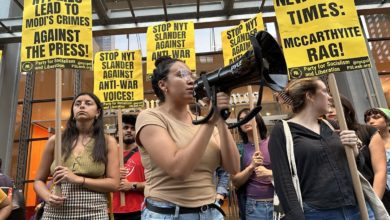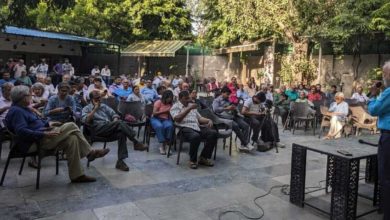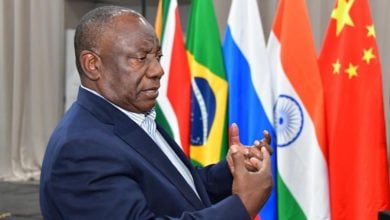 Tsunami survivors wait for relief materials in a relief camp in southern Sri Lanka, Jan. 12. Photo: Kim Ludbrook |
The death and destruction caused by the tsunamis is almost unimaginable. Three weeks after the earthquake, over 165,000 were confirmed dead. Hundreds of thousands more are missing and wounded. Five million are hungry and homeless—850,000 in Sri Lanka alone—with the threat of death from disease and contaminated water imminent.
The tsunamis directly battered 11 countries, but at least 40 more countries lost nationals in the tragedy. Most affected were the oppressed countries of Indonesia, Sri Lanka, India, Thailand, Malaysia, Myanmar, Bangladesh, the Maldives and Somalia.
Workers around the world responded with an outpouring of support for victims of the disaster.
The U.S. government—the greatest exploiter on earth—is sending aid. The Bush administration initially offered the paltry sum of $15 million. After the world reacted with contempt, the U.S. package eventually increased to $350 million. Many have criticized the low amount, especially since the U.S. is the richest country in the world.
Whatever the U.S. government ends up giving, its main priorities are clear. Unlimited billions of dollars are reserved for war and occupation. A tiny fraction of that goes to meet human needs.
A bigger question is: What are the aims of U.S. aid?
U.S. political leaders seek to advance U.S. military and corporate interests in the “aid” it offers. There are strings attached to whatever it gives.
Profits over people’s needs
Neither humans nor technology could have stopped the earthquake from happening. But tens of thousands of lives could have been saved if the Indian Ocean had a warning system in place like the Pacific region does. An evacuation plan for natural disasters and centralized, coordinated relief efforts also could have saved more lives.
The disaster happened in the context of societies divided by class. The tsunamis struck countries emerging from the legacy of colonial and neo-colonial domination by Western powers. These countries are still attempting to overcome centuries of brutal exploitation at the hands of capitalist oppressors, like the U.S., the Netherlands, Britain and Italy.
Today, imperialist globalization is subjugating those south Asian and African countries in a new form, through greater plunder of resources and labor.
Aceh, the province of Indonesia closest to the earthquake, is resource-rich, yet very poor. Most of its vast oil, natural gas and other resources are exported by corporations like U.S.-based Exxon Mobil. These corporations have uprooted farmers from their land, forcing them into low-wage jobs in coastal cities. Now more people in Aceh live near the ocean than ever before. The story is similar throughout south Asia.
Globalization pushed these workers to settle in areas most exposed to the threats of earthquakes, tsunamis and tropical storms.
Also significant is the effect that environmental ruin had in magnifying the tsunami’s destruction. On virtually every coastline, from Thailand to Sri Lanka, the drive for tourism profits caused the almost total removal of mangroves and coral reefs. These are both natural barriers that could have saved many lives.
Under capitalism, governments care more about profits than people.
 From south Asia to East Africa, the Indian Ocean tsunamis impacted millions of the world’s poor. |
The disaster is superimposed over the political struggles that are taking place. A fault line in the Indian Ocean initiated this disaster. But the biggest fault line in the world today is between imperialism and the oppressed.
What are U.S. imperialist aims in the region?
The U.S. is taking full advantage of the tsunami disaster to extend its military presence where it would not have been able to do so previously. It is conducting its largest military operation in Asia since the Vietnam War.
The U.S. seeks greater military clout and control over the region. There is speculation that the U.S. military could remain in the area for up to six months. (Mediacorp, Jan. 5)
A U.S. aircraft carrier with 6,000 sailors on board—the USS Abraham Lincoln—is currently stationed about 15 miles off Aceh.
Most U.S. tsunami aid is being delivered by the military. Backed by an array of U.S. warships, planes and helicopters, more than 13,000 U.S. marines and other military personnel are on the ground in Indonesia, Thailand and Sri Lanka. There are 21 ships, 14 cargo planes and more than 90 military helicopters in the region. (BBC World, Jan. 6)
When some 1,500 U.S. marines landed on Sri Lanka, the main Tamil nationalist group, the Liberation Tigers of Tamil Eelam, denounced the U.S. presence: “The attempt by the American and Indian troops to land in Sri Lanka is totally based on their political and military interests.” (PA News, Jan. 4)
The Sri Lankan New Left Front also spoke out against imperialist intervention. In a statement, the NLF called on all “oppressed people and the left and democratic forces” to protest the induction of foreign troops while pretending to help tsunami victims. The NLF accused the U.S. of forcing Sri Lanka to go along with “global capitalism” in order to consolidate its “neo-colonial agenda.” (TNS News, Jan. 4)
In Aceh, U.S. troops are playing a leading role in the relief operations, along with the Indonesian military. Private U.S. corporations in Aceh are currently paying the Indonesian military to guard their investments. The U.S. military is in Aceh to help safeguard these interests, not to render aid to victims of a natural disaster.
U.S. “humanitarian [aid] is not purely humanitarian,” noted Sri Lankan political scientist Jayadeva Uyangoda. (Reuters, Jan. 3)
The U.S. is also using the tsunamis to bring India more into its orbit.
India is a member of the “core group,” a U.S. initiative. It is comprised of the U.S., India, Australia and Japan. The U.S. invited India to bring it “closer” while still assuring U.S., Japanese and Australian imperialist military and strategic control of the situation.
Since the overthrow of the Soviet Union—India’s long-time trading partner—the U.S. has made inroads with its government and economy. The U.S. is now India’s leading foreign investor and largest trading partner. It sees a wealth of cheap labor and has labeled India one of the world’s ten, “big, emerging markets.”
Despite 16,000 deaths and significant damage, the Indian government refused foreign aid. India’s national bourgeoisie wants to maintain some independence from U.S. and European economic domination.
In addition, the U.S. wants to improve its image in the Muslim world by spearheading relief efforts. Indonesia has the world’s largest Muslim population.
It is the height of hypocrisy for the U.S. government to pretend it cares about anyone in south Asia after killing 1.5 million Iraqis with 13 years of genocidal sanctions. And now the U.S. is trying to demolish Iraq, unleashing fierce weapons on the people. The U.S. war and occupation has killed over 100,000 Iraqis since March 2003.
 Revolutionaries gained broad support through relief efforts and political organizing after the 1972 Managua earthquake. |
When disaster strikes, the contradictions inherent in capitalist societies are exacerbated and heightened. Such a disaster, however debilitating, can change the climate of class struggle.
It is easier for the ruling classes to take advantage of a disaster. The working class always bears the brunt of the destruction. But, in times of crisis, class conscious workers look for ways to put the crisis on the backs of the ruling class. In recent history, the working class scored victories after disasters in Nicaragua and Ethiopia.
Nicaragua’s Sandinistas began to attract significant support from the country’s workers and peasants after an earthquake leveled the capital, Managua, on December 23, 1972.
The earthquake killed 20,000 of the city’s 400,000 residents and left 250,000 homeless. Somoza’s National Guard embezzled much of the international aid that flowed into the country. The Sandinistas organized relief efforts and agitated against Somoza’s corruption, causing their ranks to swell. With mass support, the Sandinistas overthrew the dictatorship and established a progressive government in 1979.
In Ethiopia, 1972-73 were years of severe drought and famine. Hundreds of thousands died. The ruling monarchy headed by imperialist puppet Haile Selassie did little to resolve the crisis. Property relations were feudal and the landowners held supreme power. Ethiopia was also engulfed in a civil war with separatists in Eritrea.
The famine and war created a deepening crisis for the Ethiopian government. Progressive elements in the military responded by staging a rebellion that ousted Selassie. A military council, known as the Derg, replaced him. They introduced broad and profound social revolution to the workers and peasants of Ethiopia.
Revolutionaries look for opportunities to advance the class struggle in every situation imposed on them—whether by history or nature. The world capitalist media heaps scorn on progressive forces that try to organize relief without relying on the forces of imperialism. But that is their right and duty—and they deserve the support of all who sincerely seek to show solidarity with the victimized working people in south Asia.
No humanitarian solution with imperialism
The effects of a natural disaster of this magnitude are compounded greatly by national and class oppression. Yet after every disaster, the ruling class and the bourgeois press preach that natural disasters can unite rich and poor. This notion is false.
The solidarity of the world’s people must not be used to increase the dependence of the affected region’s workers on the governments and imperialism. Effective solidarity means anti-imperialism.
There is no such thing as a general humanitarian solution to natural disasters in a world dominated by imperialism.
The long-term consequences of the tsunamis are impossible to predict both regionally and globally. There is the potential for regional destabilization. So many poor areas were hit, and very few can adequately provide relief or hope for desperate survivors.
The tsunamis put the injustice of the global capitalist system on display for all to see. Capitalism causes poverty, disease, death, environmental destruction, racism, homelessness, hunger and more. All of this misery must end. Making the advancement of the class struggle our first priority will move humanity closer to this goal.






